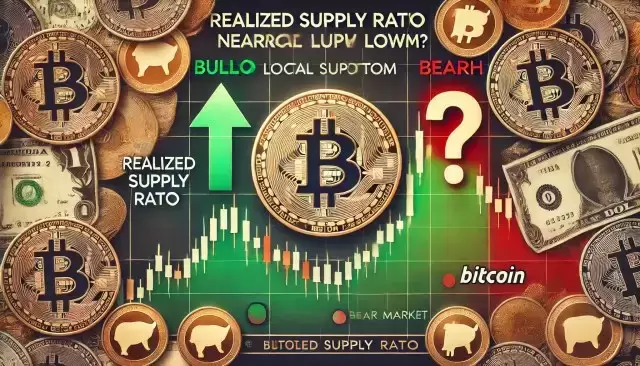 |
|
 |
|
 |
|
 |
|
 |
|
 |
|
 |
|
 |
|
 |
|
 |
|
 |
|
 |
|
 |
|
 |
|
 |
|
以太坊正在挣扎,因此,分散的金融(DEFI)遭受了苦难。第2层(L2)溶液的流动性破裂
Layer-2 solutions for Ethereum have failed to deliver on their promise of scaling the network and have instead fractured liquidity, rendering capital inefficient. As a result, many in the crypto community are searching for greener pastures.
以太坊的第2层解决方案未能兑现其扩展网络的承诺,而是使流动性破裂,使资本效率低下。结果,加密社区中的许多人都在寻找更绿色的牧场。
However, Solana, which many have pointed to as an alternative, has seen its ecosystem overrun by memecoins, which are used for pump-and-dump schemes, liquidity extraction and fraud.
但是,许多人指出的索拉纳(Solana)已将其生态系统覆盖为Memecoins,该生态系统被用于泵送和降低计划,流动性提取和欺诈。
The only network that can sustain the next evolution of decentralized finance aligns with Satoshi’s original vision of a decentralized financial system and is being powered by the most trusted and decentralized network in the digital economy — Bitcoin.
唯一能够维持分散财务与Satoshi对分散金融体系的原始愿景的下一个进化的网络,并且由数字经济中最受信任和最转化的网络提供动力 - 比特币。
Ethereum was once the undisputed home of decentralized finance, but today, it’s clear that the ecosystem is struggling. The network’s roadmap is constantly changing, and there’s no clear path toward long-term sustainability.
以太坊曾经是分散财务的无可争议的故乡,但今天,很明显,生态系统正在挣扎。该网络的路线图正在不断变化,并且没有通往长期可持续性的明确途径。
Layer-2 solutions were supposed to scale Ethereum and increase its throughput, and they have certainly achieved that. However, they’ve also fractured DeFi into isolated liquidity silos. While L2s have lowered transaction fees, they now compete for liquidity rather than contributing to a unified financial system.
第2层解决方案应该扩展以太坊并增加其吞吐量,他们当然已经实现了这一目标。但是,他们还将Defi破裂成孤立的流动性孤岛。尽管L2降低了交易费用,但他们现在争夺流动性,而不是为统一的金融体系做出贡献。
The result? A fragmented landscape that makes capital inefficient and DeFi protocols harder to scale.
结果?一个零散的景观,使资本效率低下,更符合规程更难扩展。
Ethereum’s proposed solution — chain abstraction — sounds promising in theory but fails in practice. The fundamental issue is a structural misalignment of incentives, and as a result, Ethereum is gradually losing its competitive edge in DeFi.
以太坊提出的解决方案 - 链的抽象 - 理论上听起来很有希望,但在实践中失败了。基本问题是激励措施的结构错位,因此,以太坊逐渐失去了其在Defi中的竞争优势。
It’s time to ask: Can DeFi’s future lie in a fragmented Ethereum?
是时候问:Defi的未来可以在于零散的以太坊吗?
Solana has seen an 83% increase in developer activity year-over-year, and its decentralized exchanges have outperformed Ethereum’s for five consecutive months. However, there’s a fundamental problem: Solana’s DeFi growth isn’t built on sustainable financial applications — it’s fueled by a memecoin frenzy.
Solana的开发人员活动同比增长了83%,其分散交易所连续五个月超过以太坊的交流。但是,存在一个基本问题:Solana的Defi增长不是基于可持续财务应用的建立,而是由Memecoin Frenzy推动的。
The recent surge in activity isn’t driven by innovation in decentralized finance but by speculative trades. Following the TRUMP memecoin craze, the total extracted value from Solana’s memecoins ranged between $3.6 billion and $6.6 billion. This isn’t DeFi growth — it’s a liquidity extraction engine where short-term speculators cash in and move on.
最近的活动激增并非由分散财务的创新驱动,而是由投机行业驱动。在特朗普的纪念物热潮之后,从索拉纳(Solana)的纪念物中提取的总价值在36亿至66亿美元之间。这不是Defi增长 - 这是一种流动性提取引擎,短期投机者可以兑现并继续前进。
Solana has real strengths. Its speed and low transaction costs make it ideal for high-frequency trading, and its ecosystem has made meaningful strides in decentralized physical infrastructure networks (DePINs), AI and decentralized science, or DeSci. But the dominance of memecoin speculation has turned the chain into a playground for fraud and pump-and-dump schemes. That’s not the foundation DeFi needs.
Solana具有真正的优势。它的速度和低交易成本使其非常适合高频交易,并且其生态系统在分散的物理基础设施网络(DEPIN),AI和分散的科学或Desci中取得了有意义的进步。但是,Memecoin猜测的主导地位将链条变成了一个欺诈和泵送计划的操场。那不是基础的需求。
Solana isn’t the answer if the goal is to build a lasting financial system.
如果目标是建立持久的金融体系,那么Solana不是答案。
Instead, we need to return to first principles and build DeFi on the original blockchain: Bitcoin — the most trusted, decentralized network backed by the soundest money in the digital economy.
取而代之的是,我们需要返回第一原则,并在原始区块链上建立defi:比特币 - 比特币是最受信任的,分散的网络,由数字经济中最合理的资金支持。
This isn’t just theoretical. Bitcoin DeFi is already experiencing explosive growth. Consider the numbers: Total value locked (TVL) in Bitcoin DeFi surged from $300 million in early 2024 to $5.4 billion as of Feb. 28, 2025 — a staggering 1,700% increase. The Bitcoin staking sector is dominating, with protocols like Babylon ($4.68 billion TVL), Lombard ($1.59 billion) and SolvBTC ($715 million) leading the charge. This demonstrates the growing demand for Bitcoin to become a productive asset rather than a passive store of value.
这不仅仅是理论上。比特币Defi已经在经历爆炸性的增长。考虑数字:比特币Defi的总价值锁定(TVL)从2024年初的3亿美元增加到截至2025年2月28日的54亿美元,增长了1,700%。比特币的Staking行业占主导地位,巴比伦(46.8亿美元的TVL),Lombard(15.9亿美元)和SOLVBTC(7.15亿美元)等协议领导了这一费用。这表明对比特币成为生产资产而不是被动价值存储的需求不断增长。
Bitcoin-native DeFi isn’t simply copying Ethereum’s playbook — it’s pioneering new financial models. Advancements in the space have introduced dual staking, allowing users to stake BTC alongside native tokens to enhance security and earn yields. Meanwhile, novel approaches to tokenizing Bitcoin’s hashrate turn mining power into collateral for lending, borrowing and staking, further expanding Bitcoin’s financial utility.
比特币本地Defi不仅仅是复制以太坊的剧本,还开创了新的财务模型。该领域的进步已经引入了双重积分,使用户可以将BTC与原始令牌一起存放以提高安全性并赚取收益率。同时,将比特币的哈希底币矿业能力转化为贷款,借贷和积累,进一步扩大比特币的金融公用事业的新颖方法。
In addition, Ordinals and BRC-20 tokens have driven record-high transaction activity, with inscriptions reaching 66.7 million and generating $420 million in fees — highlighting the growing demand for tokenized assets on Bitcoin.
此外,Ordinals和BRC-20代币还推动了创纪录的交易活动,铭文达到6670万,并产生了4.2亿美元的费用 - 强调了对比特币对标记资产的需求不断增长。
It is clear that Bitcoin is no longer just digital gold — it’s becoming the foundation for the next phase of decentralized finance.
显然,比特币不再仅仅是数字黄金 - 它已成为下一个分散融资的基础。
The future of DeFi lies with Bitcoin, where incentives align with long-term value creation. Unlike Ethereum’s fragmented model and Solana’s speculative economy, Bitcoin-based DeFi is built on institutional-grade liquidity and sustainable growth.
Defi的未来在于比特币,激励措施与长期价值创造相吻合。与以太坊的零散模型和Solana的投机性经济不同,基于比特币的DEFI建立在机构级的流动性和可持续增长的基础上。
As the largest and most liquid crypto asset, Bitcoin boasts a $1.7 trillion market cap and $94 billion in exchange-traded fund (ETF) holdings. Even a fraction of this liquidity migrating into DeFi would be a game-changer. Bitcoin holds over $1 trillion in untapped liquidity and continues to attract strong interest from institutional investors and sovereign wealth funds, with governments already exploring it as a potential reserve asset.
作为最大和最流动的加密资产,比特币拥有1.7万亿美元的市值和940亿美元的交易所基金(ETF)持股。即使是将这种流动性迁移到DEFI的一小部分也会改变游戏规则。比特币持有超过1万亿美元的未开发的流动性,并继续引起机构投资者和主权财富基金的浓厚兴趣,政府已经将其作为潜在的储备资产探索。
Several
一些
免责声明:info@kdj.com
所提供的信息并非交易建议。根据本文提供的信息进行的任何投资,kdj.com不承担任何责任。加密货币具有高波动性,强烈建议您深入研究后,谨慎投资!
如您认为本网站上使用的内容侵犯了您的版权,请立即联系我们(info@kdj.com),我们将及时删除。
-

-

-

-

- 名人加密热潮:Elon Musk和Dogecoin
- 2025-04-05 12:35:12
- 长期以来,加密货币市场吸引了来自各个行业的备受瞩目的人物。
-

- 比特币(BTC)目前正在超过关键支持
- 2025-04-05 12:30:11
- 比特币目前的交易高于关键支持,但公牛队正在努力收回90000美元的水平,这一门槛可能标志着有意义的恢复集会的开始。
-

- 比特币(BTC)表现出弹性,因为股市因美国关税而下降
- 2025-04-05 12:30:11
- 随着由于美国大多数贸易伙伴的关税,股票市场的下降,比特币表现出了一些韧性。 Unchained的专家解释了原因。
-

- 雪崩(Avax)正在获得机构信心,其中一些人预测其价值会显着上升
- 2025-04-05 12:25:12
- 这种雄心勃勃的预测是在以太坊(ETH)似乎失去优势的时候,而雪崩的成长轨迹继续加速。
-

-


























































